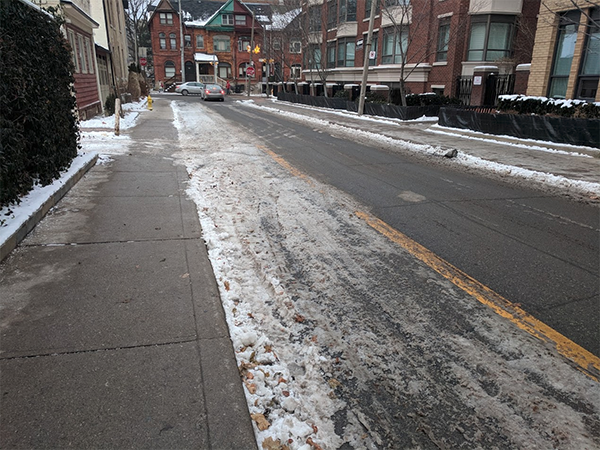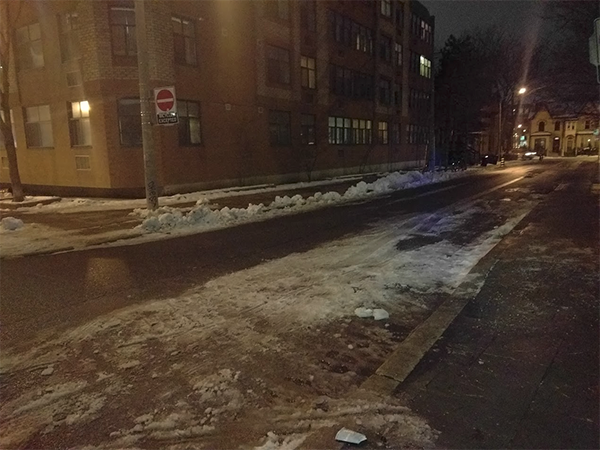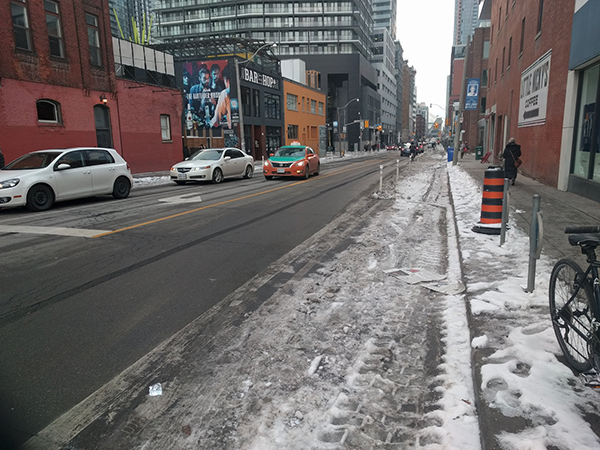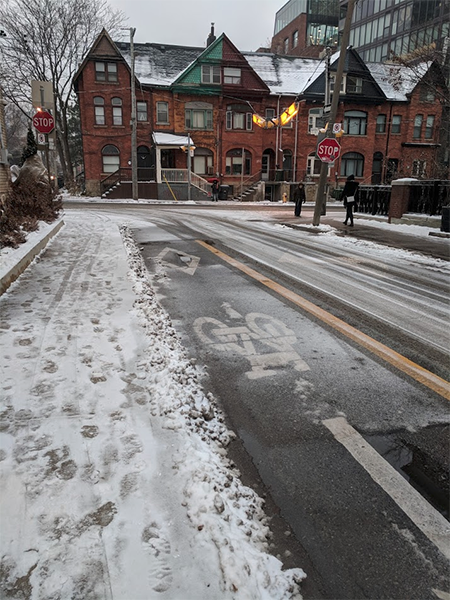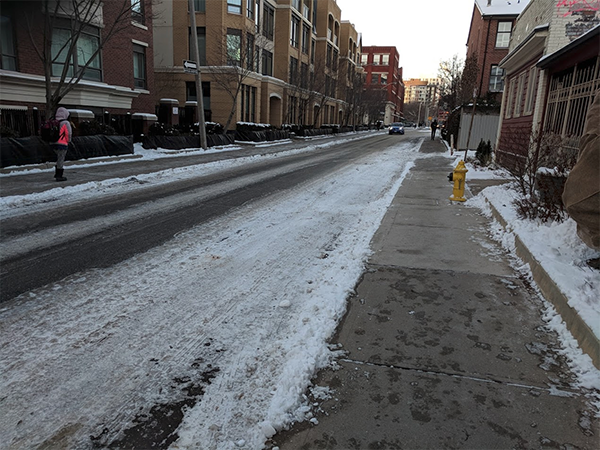
Proper winter maintenance is in the details

What good is a bike lane if you can't use it?
Guest blog and photos by Anton Lodder
Winter is back, and with it a familiar experience in Canadian cities: the sight of blue flashing lights on giant orange trucks, the scrape of massive blades on asphalt, the piles of snow, and the disappearance of a number of bike lanes under a crust of ice – not to be seen until the next real thaw, or maybe even until spring.
Luckily for those of us riding bikes through the winter, this description has become a little less true for a few of our most popular cycling routes. Since 2015, the City of Toronto has committed to performing snow maintenance on a selection of Priority Cycling Snow Routes in the downtown core, including East-West routes on Richmond, Adelaide, College, and Harbord/Wellesley as well as North-South routes on Shaw, Sherbourne, and Simcoe/Beverly/St.George. If you've been out in the streets on your bike in the past few winters you may have noticed the dedicated plows operating on major routes, and you've probably also been encouraged by the increasing numbers of people continuing to ride their bikes in snowy weather.
Unfortunately, while the city is sending out plows and salters to our bike lanes, they aren't always doing a thorough job. Case in point, the contra-flow bike lanes on Phoebe St. and Stephanie St. These are two seemingly insignificant links in Toronto's cycling network – they go along small, quiet one-way streets, away from the busy traffic and uncontrolled intersections on Queen Street and St. George; they are just bike lanes, not real cycle-tracks with planters or traffic lights; and they are short, no more than 50 metres end-to-end.
However, these short stretches of bike lane are vital links for people travelling south in the morning on St. George, looking to connect with Richmond, Adelaide and Simcoe Streets on their way downtown. On a warm fall day you'll see cyclists taking the corner onto Stephanie in groups of three as they head into the Financial District for a day's work. Others jog west on Phoebe, making their way to the Peter Street lanes and destinations in the Entertainment District.
These lanes are clearly well-used, and given the fact that they are listed on the city's priority map of winter-maintained cycling infrastructure, you would think that they would be a priority for winter maintenance. Alas – try to bike through in the week following a major snowfall and you'll likely find these lanes out of commission. After just one minor snowfall, the Phoebe Street bike lane was fully obscured by a thick pack of icy snow complete with auto tire tracks. You'd be forgiven for wondering if there is even a bike lane underneath all that snow and ice.
Phoebe, two days after a snow-storm.
And in case you think this is an isolated oversight, let me tell you that it is common to find these cycling lanes covered in thick layers of ice, crowded out by windrows or just missed altogether by city plows.
Phoebe St. bike lane under a thick layer of ice.
Snow dumped in the intersection at John and Stephanie, making it impossible to turn the corner (2016).
Peter Street cycle track, looking forgotten (2016).
Don't get me wrong - I'm thrilled that we have a dedicated program to maintain bike routes for winter cycling, and although we don't necessarily use the best practices for bike lane maintenance, most of the routes do get cleared most of the time. But we shouldn't be losing sight of the details that cause our cycling network to no longer function, such as forcing people walking and on bikes to share space too tightly or just not following through on infrastructure that’s supposed to be protected from motor vehicle traffic.
Similarly, not prioritizing clearing snow from well-used cycling routes sends the message that people riding bikes must fend for themselves, sometimes putting their lives at risk by being forced to ride over dangerous ice and snow, or to ride in mixed traffic on busy streets. We need our snow removal staff to actually do the job of removing snow on the few routes that are available to winter cyclists, and we need them do so with a goal of making them useable by bike, from end to end. That means paying extra attention to key connecting routes like Phoebe and Stephanie, and ensuring intersections don’t have snow in cycle tracks and bike lanes. Is that too much to ask?
Maybe you're thinking "Well gee, how much do you want us to spend on clearing bike lanes?" But consider that the City of Toronto spends nearly $100 million annually to clear over five-thousand kilometers of roadway; we have a 30-km underground tunnel system for people to walk between offices and subway stations in the core; and, we operate PlowTO, a web-connected mapping system that allows residents to see in real-time the location of City plows on their local streets. Actually making sure the snow is fully cleared on the few bike routes that the City has committed to maintaining seems like a reasonable ask to me.
Phoebe Street after being properly cleared – it is possible to do this well.
Snow in the bike lane got you down?
- Become a member this month and you’ll contribute to healthy, safe, cycling-friendly city for all - throughout all seasons.
- Call 311 to submit a service request; we also recommend that you call or e-mail your City Councillor, let them know you're a member of Cycle Toronto, and indicate where bike lanes are blocked by snow, ice, or debris,
- Join us on Saturday, February 3rd at noon for our annual Coldest Day of the Year Ride along some of the city's best (and cleared) infrastructure!
- Share your experiences riding a bike during winter with us on Twitter, Instagram, or Facebook.

